Unit 41 Brand Management Report: Tesco Brand Analysis
VerifiedAdded on 2023/01/05
|18
|5607
|65
Report
AI Summary
This report provides a comprehensive analysis of brand management, focusing on Tesco as a case study. It explores the importance of branding as a marketing tool, examining how it generates revenue, builds customer preference, and expands company value. The report delves into key components of a successful brand strategy, including target audience, brand value, positioning, and competitive analysis. Furthermore, it analyzes different strategies of portfolio management, brand hierarchy, and brand equity management, as well as brand leverage and collaborations. The report also discusses techniques for measuring and managing brand value, providing insights into Tesco's competitive approach within the retail industry. The report covers a range of topics including the importance of branding, key components of a successful brand strategy, strategies of portfolio management, brand hierarchy and brand equity management, brands leverage and collaborations, and different types of techniques for measuring and managing brand value. The report concludes with an evaluation of the functional scenarios on brand management goals for gaining larger horizons and to formulate new scope onto larger efficacy parameters.

Brand Management
Paraphrase This Document
Need a fresh take? Get an instant paraphrase of this document with our AI Paraphraser
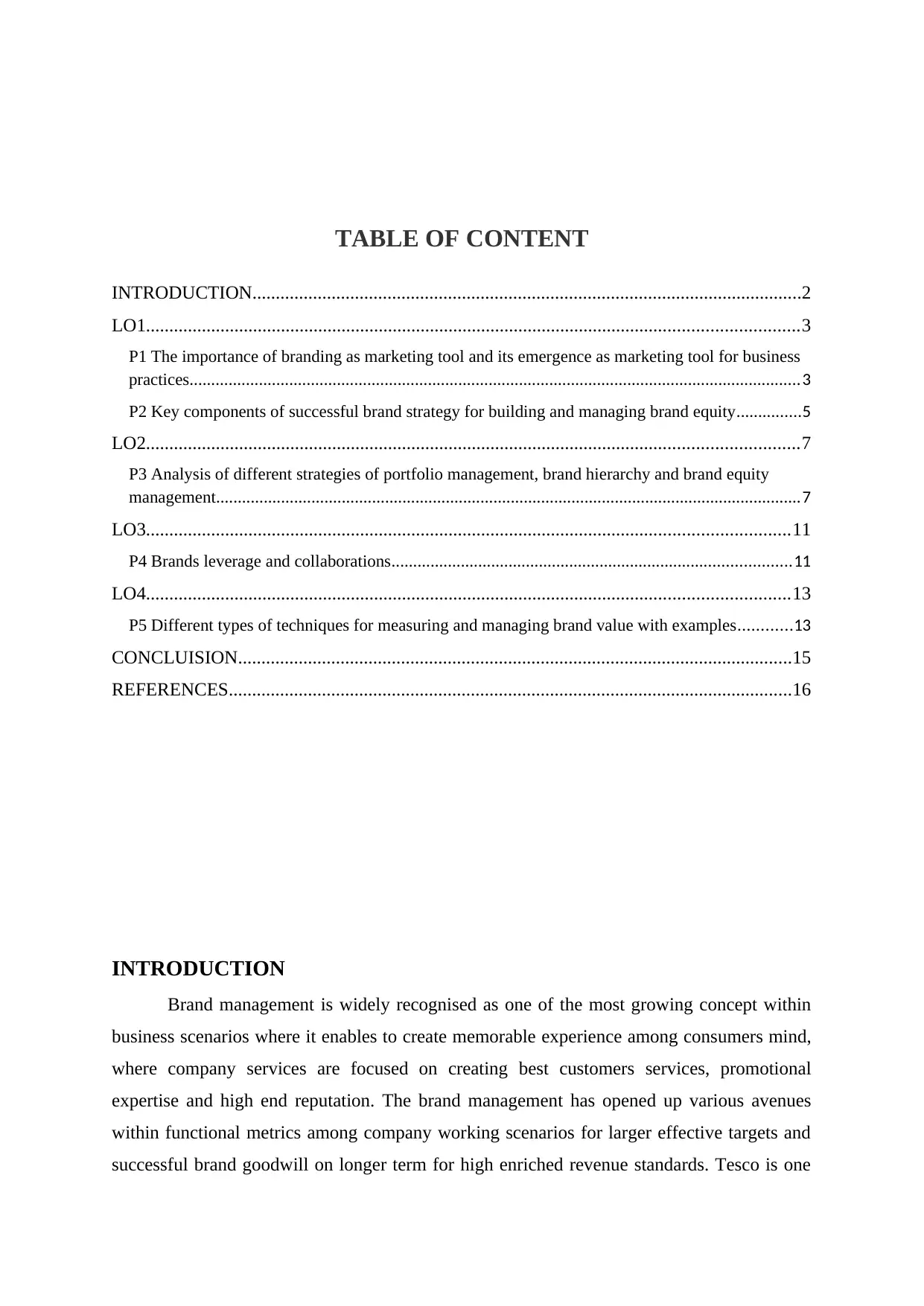
TABLE OF CONTENT
INTRODUCTION......................................................................................................................2
LO1............................................................................................................................................3
P1 The importance of branding as marketing tool and its emergence as marketing tool for business
practices.............................................................................................................................................3
P2 Key components of successful brand strategy for building and managing brand equity...............5
LO2............................................................................................................................................7
P3 Analysis of different strategies of portfolio management, brand hierarchy and brand equity
management.......................................................................................................................................7
LO3..........................................................................................................................................11
P4 Brands leverage and collaborations............................................................................................11
LO4..........................................................................................................................................13
P5 Different types of techniques for measuring and managing brand value with examples............13
CONCLUISION.......................................................................................................................15
REFERENCES.........................................................................................................................16
INTRODUCTION
Brand management is widely recognised as one of the most growing concept within
business scenarios where it enables to create memorable experience among consumers mind,
where company services are focused on creating best customers services, promotional
expertise and high end reputation. The brand management has opened up various avenues
within functional metrics among company working scenarios for larger effective targets and
successful brand goodwill on longer term for high enriched revenue standards. Tesco is one
INTRODUCTION......................................................................................................................2
LO1............................................................................................................................................3
P1 The importance of branding as marketing tool and its emergence as marketing tool for business
practices.............................................................................................................................................3
P2 Key components of successful brand strategy for building and managing brand equity...............5
LO2............................................................................................................................................7
P3 Analysis of different strategies of portfolio management, brand hierarchy and brand equity
management.......................................................................................................................................7
LO3..........................................................................................................................................11
P4 Brands leverage and collaborations............................................................................................11
LO4..........................................................................................................................................13
P5 Different types of techniques for measuring and managing brand value with examples............13
CONCLUISION.......................................................................................................................15
REFERENCES.........................................................................................................................16
INTRODUCTION
Brand management is widely recognised as one of the most growing concept within
business scenarios where it enables to create memorable experience among consumers mind,
where company services are focused on creating best customers services, promotional
expertise and high end reputation. The brand management has opened up various avenues
within functional metrics among company working scenarios for larger effective targets and
successful brand goodwill on longer term for high enriched revenue standards. Tesco is one
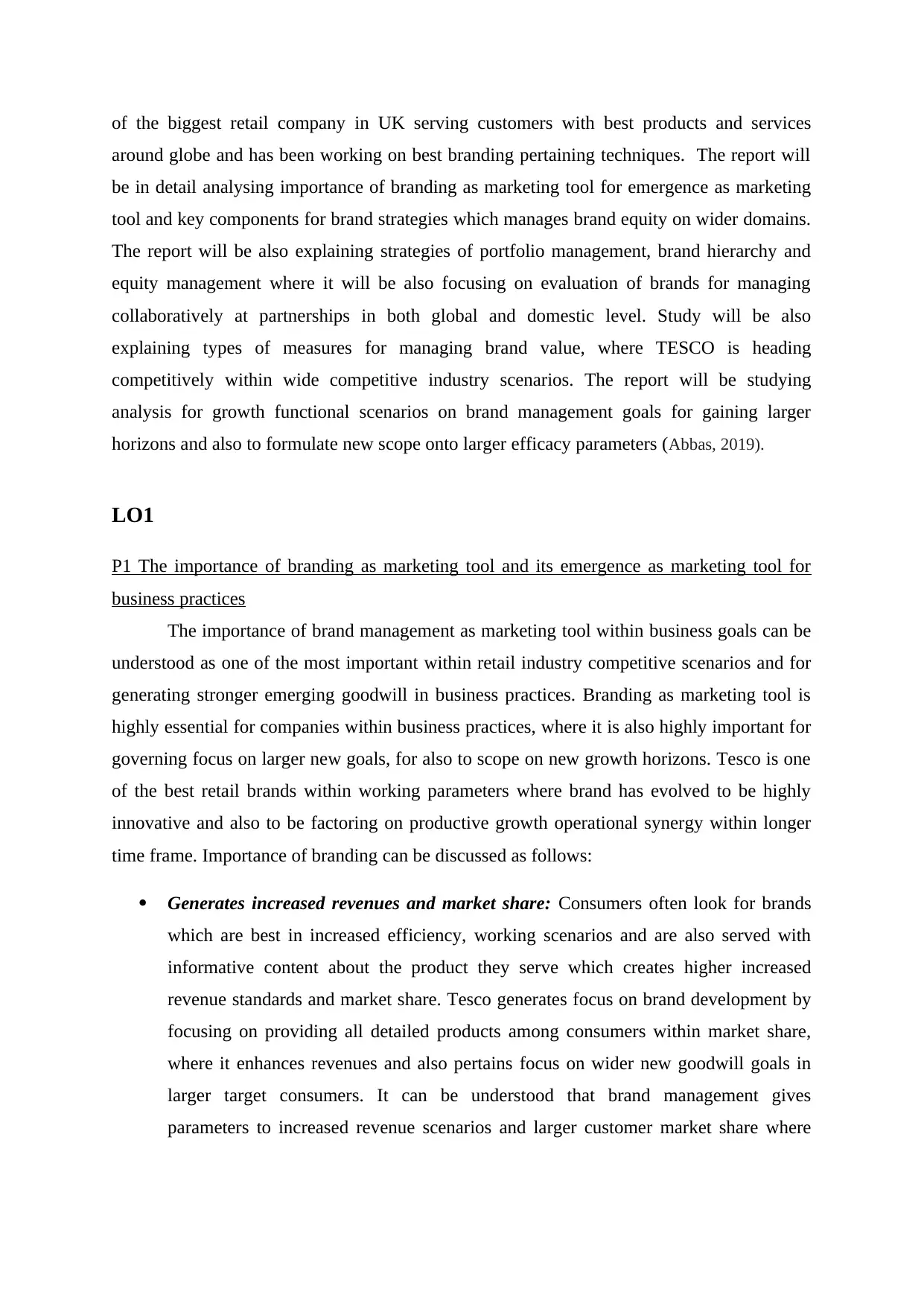
of the biggest retail company in UK serving customers with best products and services
around globe and has been working on best branding pertaining techniques. The report will
be in detail analysing importance of branding as marketing tool for emergence as marketing
tool and key components for brand strategies which manages brand equity on wider domains.
The report will be also explaining strategies of portfolio management, brand hierarchy and
equity management where it will be also focusing on evaluation of brands for managing
collaboratively at partnerships in both global and domestic level. Study will be also
explaining types of measures for managing brand value, where TESCO is heading
competitively within wide competitive industry scenarios. The report will be studying
analysis for growth functional scenarios on brand management goals for gaining larger
horizons and also to formulate new scope onto larger efficacy parameters (Abbas, 2019).
LO1
P1 The importance of branding as marketing tool and its emergence as marketing tool for
business practices
The importance of brand management as marketing tool within business goals can be
understood as one of the most important within retail industry competitive scenarios and for
generating stronger emerging goodwill in business practices. Branding as marketing tool is
highly essential for companies within business practices, where it is also highly important for
governing focus on larger new goals, for also to scope on new growth horizons. Tesco is one
of the best retail brands within working parameters where brand has evolved to be highly
innovative and also to be factoring on productive growth operational synergy within longer
time frame. Importance of branding can be discussed as follows:
Generates increased revenues and market share: Consumers often look for brands
which are best in increased efficiency, working scenarios and are also served with
informative content about the product they serve which creates higher increased
revenue standards and market share. Tesco generates focus on brand development by
focusing on providing all detailed products among consumers within market share,
where it enhances revenues and also pertains focus on wider new goodwill goals in
larger target consumers. It can be understood that brand management gives
parameters to increased revenue scenarios and larger customer market share where
around globe and has been working on best branding pertaining techniques. The report will
be in detail analysing importance of branding as marketing tool for emergence as marketing
tool and key components for brand strategies which manages brand equity on wider domains.
The report will be also explaining strategies of portfolio management, brand hierarchy and
equity management where it will be also focusing on evaluation of brands for managing
collaboratively at partnerships in both global and domestic level. Study will be also
explaining types of measures for managing brand value, where TESCO is heading
competitively within wide competitive industry scenarios. The report will be studying
analysis for growth functional scenarios on brand management goals for gaining larger
horizons and also to formulate new scope onto larger efficacy parameters (Abbas, 2019).
LO1
P1 The importance of branding as marketing tool and its emergence as marketing tool for
business practices
The importance of brand management as marketing tool within business goals can be
understood as one of the most important within retail industry competitive scenarios and for
generating stronger emerging goodwill in business practices. Branding as marketing tool is
highly essential for companies within business practices, where it is also highly important for
governing focus on larger new goals, for also to scope on new growth horizons. Tesco is one
of the best retail brands within working parameters where brand has evolved to be highly
innovative and also to be factoring on productive growth operational synergy within longer
time frame. Importance of branding can be discussed as follows:
Generates increased revenues and market share: Consumers often look for brands
which are best in increased efficiency, working scenarios and are also served with
informative content about the product they serve which creates higher increased
revenue standards and market share. Tesco generates focus on brand development by
focusing on providing all detailed products among consumers within market share,
where it enhances revenues and also pertains focus on wider new goodwill goals in
larger target consumers. It can be understood that brand management gives
parameters to increased revenue scenarios and larger customer market share where
⊘ This is a preview!⊘
Do you want full access?
Subscribe today to unlock all pages.

Trusted by 1+ million students worldwide
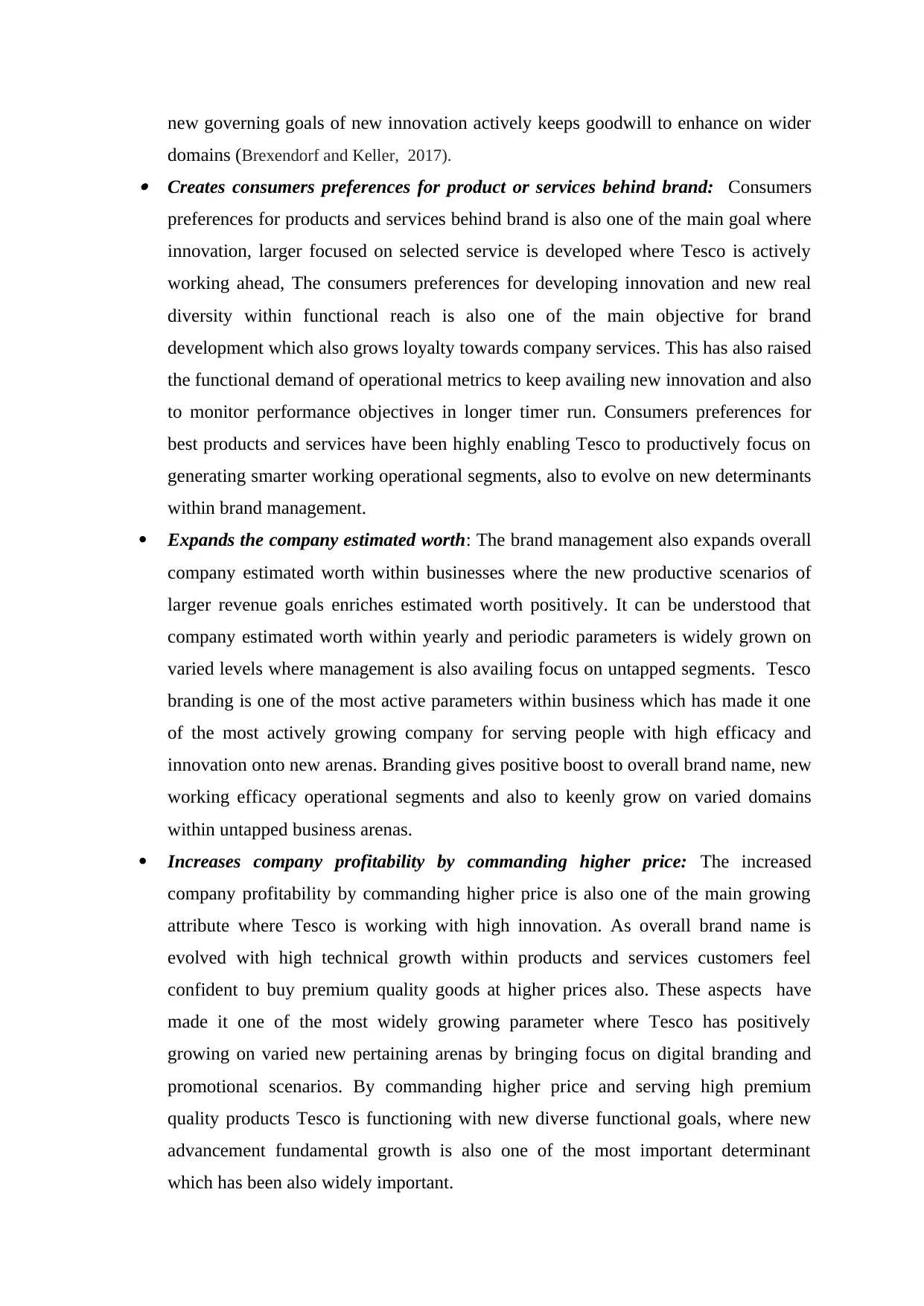
new governing goals of new innovation actively keeps goodwill to enhance on wider
domains (Brexendorf and Keller, 2017). Creates consumers preferences for product or services behind brand: Consumers
preferences for products and services behind brand is also one of the main goal where
innovation, larger focused on selected service is developed where Tesco is actively
working ahead, The consumers preferences for developing innovation and new real
diversity within functional reach is also one of the main objective for brand
development which also grows loyalty towards company services. This has also raised
the functional demand of operational metrics to keep availing new innovation and also
to monitor performance objectives in longer timer run. Consumers preferences for
best products and services have been highly enabling Tesco to productively focus on
generating smarter working operational segments, also to evolve on new determinants
within brand management.
Expands the company estimated worth: The brand management also expands overall
company estimated worth within businesses where the new productive scenarios of
larger revenue goals enriches estimated worth positively. It can be understood that
company estimated worth within yearly and periodic parameters is widely grown on
varied levels where management is also availing focus on untapped segments. Tesco
branding is one of the most active parameters within business which has made it one
of the most actively growing company for serving people with high efficacy and
innovation onto new arenas. Branding gives positive boost to overall brand name, new
working efficacy operational segments and also to keenly grow on varied domains
within untapped business arenas.
Increases company profitability by commanding higher price: The increased
company profitability by commanding higher price is also one of the main growing
attribute where Tesco is working with high innovation. As overall brand name is
evolved with high technical growth within products and services customers feel
confident to buy premium quality goods at higher prices also. These aspects have
made it one of the most widely growing parameter where Tesco has positively
growing on varied new pertaining arenas by bringing focus on digital branding and
promotional scenarios. By commanding higher price and serving high premium
quality products Tesco is functioning with new diverse functional goals, where new
advancement fundamental growth is also one of the most important determinant
which has been also widely important.
domains (Brexendorf and Keller, 2017). Creates consumers preferences for product or services behind brand: Consumers
preferences for products and services behind brand is also one of the main goal where
innovation, larger focused on selected service is developed where Tesco is actively
working ahead, The consumers preferences for developing innovation and new real
diversity within functional reach is also one of the main objective for brand
development which also grows loyalty towards company services. This has also raised
the functional demand of operational metrics to keep availing new innovation and also
to monitor performance objectives in longer timer run. Consumers preferences for
best products and services have been highly enabling Tesco to productively focus on
generating smarter working operational segments, also to evolve on new determinants
within brand management.
Expands the company estimated worth: The brand management also expands overall
company estimated worth within businesses where the new productive scenarios of
larger revenue goals enriches estimated worth positively. It can be understood that
company estimated worth within yearly and periodic parameters is widely grown on
varied levels where management is also availing focus on untapped segments. Tesco
branding is one of the most active parameters within business which has made it one
of the most actively growing company for serving people with high efficacy and
innovation onto new arenas. Branding gives positive boost to overall brand name, new
working efficacy operational segments and also to keenly grow on varied domains
within untapped business arenas.
Increases company profitability by commanding higher price: The increased
company profitability by commanding higher price is also one of the main growing
attribute where Tesco is working with high innovation. As overall brand name is
evolved with high technical growth within products and services customers feel
confident to buy premium quality goods at higher prices also. These aspects have
made it one of the most widely growing parameter where Tesco has positively
growing on varied new pertaining arenas by bringing focus on digital branding and
promotional scenarios. By commanding higher price and serving high premium
quality products Tesco is functioning with new diverse functional goals, where new
advancement fundamental growth is also one of the most important determinant
which has been also widely important.
Paraphrase This Document
Need a fresh take? Get an instant paraphrase of this document with our AI Paraphraser
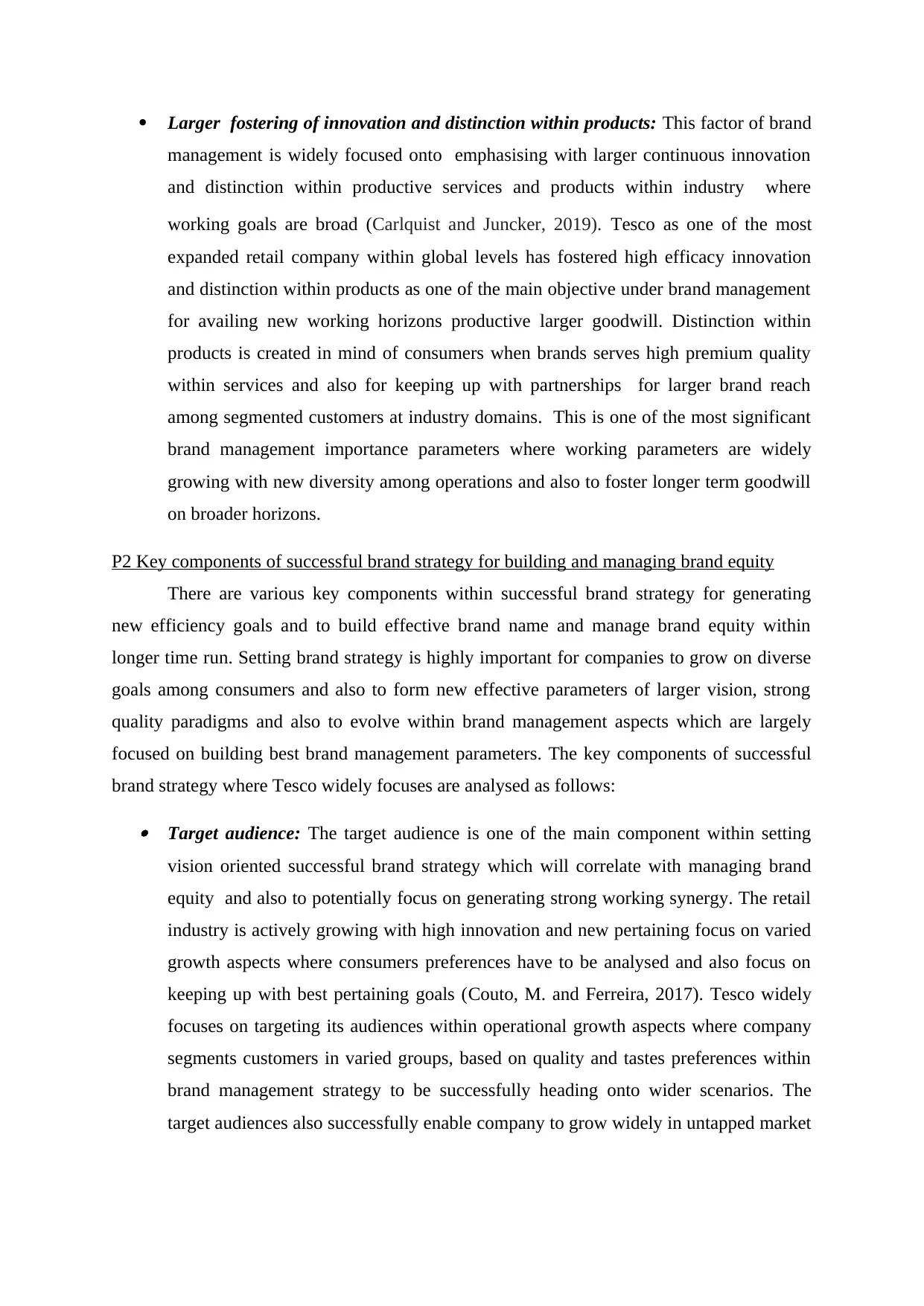
Larger fostering of innovation and distinction within products: This factor of brand
management is widely focused onto emphasising with larger continuous innovation
and distinction within productive services and products within industry where
working goals are broad (Carlquist and Juncker, 2019). Tesco as one of the most
expanded retail company within global levels has fostered high efficacy innovation
and distinction within products as one of the main objective under brand management
for availing new working horizons productive larger goodwill. Distinction within
products is created in mind of consumers when brands serves high premium quality
within services and also for keeping up with partnerships for larger brand reach
among segmented customers at industry domains. This is one of the most significant
brand management importance parameters where working parameters are widely
growing with new diversity among operations and also to foster longer term goodwill
on broader horizons.
P2 Key components of successful brand strategy for building and managing brand equity
There are various key components within successful brand strategy for generating
new efficiency goals and to build effective brand name and manage brand equity within
longer time run. Setting brand strategy is highly important for companies to grow on diverse
goals among consumers and also to form new effective parameters of larger vision, strong
quality paradigms and also to evolve within brand management aspects which are largely
focused on building best brand management parameters. The key components of successful
brand strategy where Tesco widely focuses are analysed as follows:
Target audience: The target audience is one of the main component within setting
vision oriented successful brand strategy which will correlate with managing brand
equity and also to potentially focus on generating strong working synergy. The retail
industry is actively growing with high innovation and new pertaining focus on varied
growth aspects where consumers preferences have to be analysed and also focus on
keeping up with best pertaining goals (Couto, M. and Ferreira, 2017). Tesco widely
focuses on targeting its audiences within operational growth aspects where company
segments customers in varied groups, based on quality and tastes preferences within
brand management strategy to be successfully heading onto wider scenarios. The
target audiences also successfully enable company to grow widely in untapped market
management is widely focused onto emphasising with larger continuous innovation
and distinction within productive services and products within industry where
working goals are broad (Carlquist and Juncker, 2019). Tesco as one of the most
expanded retail company within global levels has fostered high efficacy innovation
and distinction within products as one of the main objective under brand management
for availing new working horizons productive larger goodwill. Distinction within
products is created in mind of consumers when brands serves high premium quality
within services and also for keeping up with partnerships for larger brand reach
among segmented customers at industry domains. This is one of the most significant
brand management importance parameters where working parameters are widely
growing with new diversity among operations and also to foster longer term goodwill
on broader horizons.
P2 Key components of successful brand strategy for building and managing brand equity
There are various key components within successful brand strategy for generating
new efficiency goals and to build effective brand name and manage brand equity within
longer time run. Setting brand strategy is highly important for companies to grow on diverse
goals among consumers and also to form new effective parameters of larger vision, strong
quality paradigms and also to evolve within brand management aspects which are largely
focused on building best brand management parameters. The key components of successful
brand strategy where Tesco widely focuses are analysed as follows:
Target audience: The target audience is one of the main component within setting
vision oriented successful brand strategy which will correlate with managing brand
equity and also to potentially focus on generating strong working synergy. The retail
industry is actively growing with high innovation and new pertaining focus on varied
growth aspects where consumers preferences have to be analysed and also focus on
keeping up with best pertaining goals (Couto, M. and Ferreira, 2017). Tesco widely
focuses on targeting its audiences within operational growth aspects where company
segments customers in varied groups, based on quality and tastes preferences within
brand management strategy to be successfully heading onto wider scenarios. The
target audiences also successfully enable company to grow widely in untapped market
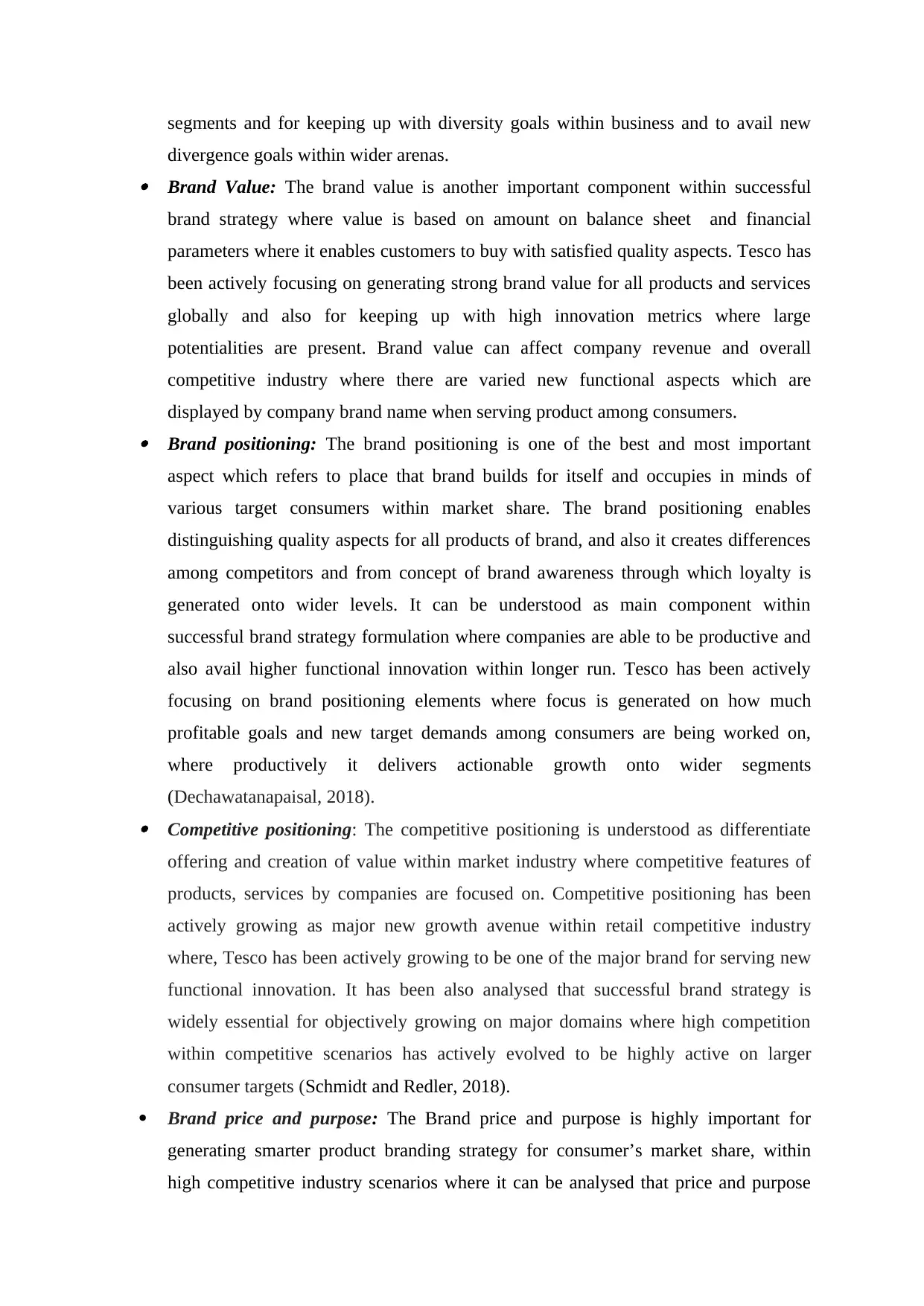
segments and for keeping up with diversity goals within business and to avail new
divergence goals within wider arenas. Brand Value: The brand value is another important component within successful
brand strategy where value is based on amount on balance sheet and financial
parameters where it enables customers to buy with satisfied quality aspects. Tesco has
been actively focusing on generating strong brand value for all products and services
globally and also for keeping up with high innovation metrics where large
potentialities are present. Brand value can affect company revenue and overall
competitive industry where there are varied new functional aspects which are
displayed by company brand name when serving product among consumers. Brand positioning: The brand positioning is one of the best and most important
aspect which refers to place that brand builds for itself and occupies in minds of
various target consumers within market share. The brand positioning enables
distinguishing quality aspects for all products of brand, and also it creates differences
among competitors and from concept of brand awareness through which loyalty is
generated onto wider levels. It can be understood as main component within
successful brand strategy formulation where companies are able to be productive and
also avail higher functional innovation within longer run. Tesco has been actively
focusing on brand positioning elements where focus is generated on how much
profitable goals and new target demands among consumers are being worked on,
where productively it delivers actionable growth onto wider segments
(Dechawatanapaisal, 2018). Competitive positioning: The competitive positioning is understood as differentiate
offering and creation of value within market industry where competitive features of
products, services by companies are focused on. Competitive positioning has been
actively growing as major new growth avenue within retail competitive industry
where, Tesco has been actively growing to be one of the major brand for serving new
functional innovation. It has been also analysed that successful brand strategy is
widely essential for objectively growing on major domains where high competition
within competitive scenarios has actively evolved to be highly active on larger
consumer targets (Schmidt and Redler, 2018).
Brand price and purpose: The Brand price and purpose is highly important for
generating smarter product branding strategy for consumer’s market share, within
high competitive industry scenarios where it can be analysed that price and purpose
divergence goals within wider arenas. Brand Value: The brand value is another important component within successful
brand strategy where value is based on amount on balance sheet and financial
parameters where it enables customers to buy with satisfied quality aspects. Tesco has
been actively focusing on generating strong brand value for all products and services
globally and also for keeping up with high innovation metrics where large
potentialities are present. Brand value can affect company revenue and overall
competitive industry where there are varied new functional aspects which are
displayed by company brand name when serving product among consumers. Brand positioning: The brand positioning is one of the best and most important
aspect which refers to place that brand builds for itself and occupies in minds of
various target consumers within market share. The brand positioning enables
distinguishing quality aspects for all products of brand, and also it creates differences
among competitors and from concept of brand awareness through which loyalty is
generated onto wider levels. It can be understood as main component within
successful brand strategy formulation where companies are able to be productive and
also avail higher functional innovation within longer run. Tesco has been actively
focusing on brand positioning elements where focus is generated on how much
profitable goals and new target demands among consumers are being worked on,
where productively it delivers actionable growth onto wider segments
(Dechawatanapaisal, 2018). Competitive positioning: The competitive positioning is understood as differentiate
offering and creation of value within market industry where competitive features of
products, services by companies are focused on. Competitive positioning has been
actively growing as major new growth avenue within retail competitive industry
where, Tesco has been actively growing to be one of the major brand for serving new
functional innovation. It has been also analysed that successful brand strategy is
widely essential for objectively growing on major domains where high competition
within competitive scenarios has actively evolved to be highly active on larger
consumer targets (Schmidt and Redler, 2018).
Brand price and purpose: The Brand price and purpose is highly important for
generating smarter product branding strategy for consumer’s market share, within
high competitive industry scenarios where it can be analysed that price and purpose
⊘ This is a preview!⊘
Do you want full access?
Subscribe today to unlock all pages.

Trusted by 1+ million students worldwide

have high role. It can be analysed that Tesco has been strongly focusing towards
setting best brand price functional parameters and availing focus on purpose which
enables to develop long term new segments of customers by setting high quality
products services. By focusing on developing brand price strategy and purpose there
is high creative efficacy generated for brand name within larger run , specially also
for serving new governing goals and also for creating higher revenue goals and
goodwill within longer working scenarios. Tesco has been keenly growing with high
innovation and diversity among operations where successful brand strategy plays
large effective role for keeping up with high working goals evolving opportunities. It
can be also potentially analysed that brand services are highly attached with price and
purpose it finally focuses on and also brand management goals widely focuses on
working with strong innovation.
The above discussed parameters have in detail discussed functional operations
parameters within setting brand management strategy in longer time run and also to
potentially focus on wider new paradigms within industry and also for stronger work
performance. Tesco has been one of the best brand within retail industry for keeping
up with high range governance and also to potentially avail higher consumer loyalty
within wider segments (Fernández Reyes and Reyes, 2018).
LO2
P3 Analysis of different strategies of portfolio management, brand hierarchy and brand equity
management
Each and every enterprise tries to build strong brand image in market so that it can
enjoy profit and higher market share for longer time frame. Therefore, it is most valuable
intangible asset of organisation. Brand portfolio management is approach that is used to
manage current and future portfolio of brands of organisation in coordinate manners so that
maximum outcome can be gained (Bhagwat and Bach, 2016). There are two basic strategies
or approaches for portfolio management such as active portfolio management and passive
portfolio management strategy that are explained below:
Active portfolio management strategy: It is strategy that emphasis on particular styles of
management that could generate maximum return or beat market. Manager of Tesco in order
to make use of active portfolio management strategy for brand management have devote high
setting best brand price functional parameters and availing focus on purpose which
enables to develop long term new segments of customers by setting high quality
products services. By focusing on developing brand price strategy and purpose there
is high creative efficacy generated for brand name within larger run , specially also
for serving new governing goals and also for creating higher revenue goals and
goodwill within longer working scenarios. Tesco has been keenly growing with high
innovation and diversity among operations where successful brand strategy plays
large effective role for keeping up with high working goals evolving opportunities. It
can be also potentially analysed that brand services are highly attached with price and
purpose it finally focuses on and also brand management goals widely focuses on
working with strong innovation.
The above discussed parameters have in detail discussed functional operations
parameters within setting brand management strategy in longer time run and also to
potentially focus on wider new paradigms within industry and also for stronger work
performance. Tesco has been one of the best brand within retail industry for keeping
up with high range governance and also to potentially avail higher consumer loyalty
within wider segments (Fernández Reyes and Reyes, 2018).
LO2
P3 Analysis of different strategies of portfolio management, brand hierarchy and brand equity
management
Each and every enterprise tries to build strong brand image in market so that it can
enjoy profit and higher market share for longer time frame. Therefore, it is most valuable
intangible asset of organisation. Brand portfolio management is approach that is used to
manage current and future portfolio of brands of organisation in coordinate manners so that
maximum outcome can be gained (Bhagwat and Bach, 2016). There are two basic strategies
or approaches for portfolio management such as active portfolio management and passive
portfolio management strategy that are explained below:
Active portfolio management strategy: It is strategy that emphasis on particular styles of
management that could generate maximum return or beat market. Manager of Tesco in order
to make use of active portfolio management strategy for brand management have devote high
Paraphrase This Document
Need a fresh take? Get an instant paraphrase of this document with our AI Paraphraser
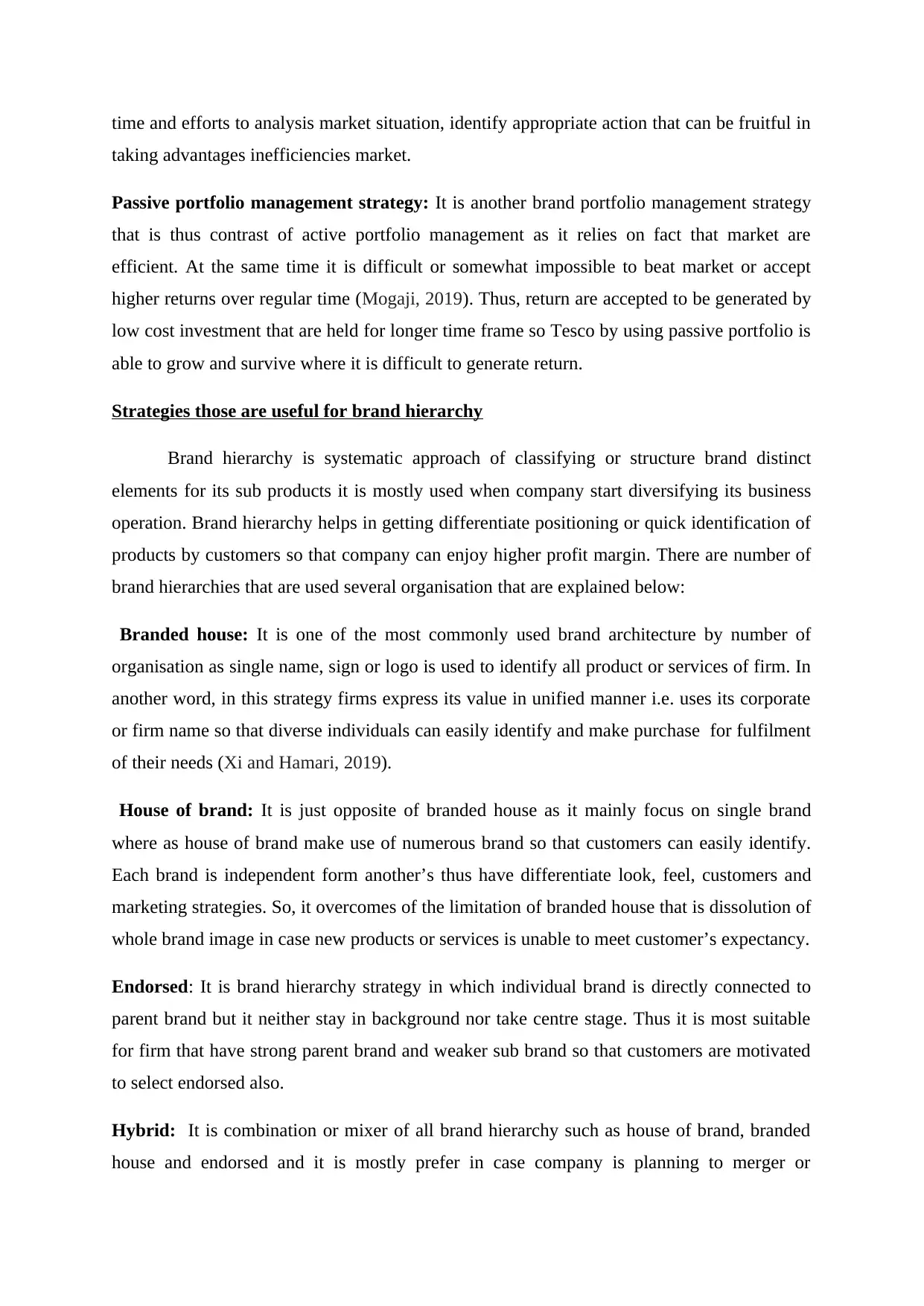
time and efforts to analysis market situation, identify appropriate action that can be fruitful in
taking advantages inefficiencies market.
Passive portfolio management strategy: It is another brand portfolio management strategy
that is thus contrast of active portfolio management as it relies on fact that market are
efficient. At the same time it is difficult or somewhat impossible to beat market or accept
higher returns over regular time (Mogaji, 2019). Thus, return are accepted to be generated by
low cost investment that are held for longer time frame so Tesco by using passive portfolio is
able to grow and survive where it is difficult to generate return.
Strategies those are useful for brand hierarchy
Brand hierarchy is systematic approach of classifying or structure brand distinct
elements for its sub products it is mostly used when company start diversifying its business
operation. Brand hierarchy helps in getting differentiate positioning or quick identification of
products by customers so that company can enjoy higher profit margin. There are number of
brand hierarchies that are used several organisation that are explained below:
Branded house: It is one of the most commonly used brand architecture by number of
organisation as single name, sign or logo is used to identify all product or services of firm. In
another word, in this strategy firms express its value in unified manner i.e. uses its corporate
or firm name so that diverse individuals can easily identify and make purchase for fulfilment
of their needs (Xi and Hamari, 2019).
House of brand: It is just opposite of branded house as it mainly focus on single brand
where as house of brand make use of numerous brand so that customers can easily identify.
Each brand is independent form another’s thus have differentiate look, feel, customers and
marketing strategies. So, it overcomes of the limitation of branded house that is dissolution of
whole brand image in case new products or services is unable to meet customer’s expectancy.
Endorsed: It is brand hierarchy strategy in which individual brand is directly connected to
parent brand but it neither stay in background nor take centre stage. Thus it is most suitable
for firm that have strong parent brand and weaker sub brand so that customers are motivated
to select endorsed also.
Hybrid: It is combination or mixer of all brand hierarchy such as house of brand, branded
house and endorsed and it is mostly prefer in case company is planning to merger or
taking advantages inefficiencies market.
Passive portfolio management strategy: It is another brand portfolio management strategy
that is thus contrast of active portfolio management as it relies on fact that market are
efficient. At the same time it is difficult or somewhat impossible to beat market or accept
higher returns over regular time (Mogaji, 2019). Thus, return are accepted to be generated by
low cost investment that are held for longer time frame so Tesco by using passive portfolio is
able to grow and survive where it is difficult to generate return.
Strategies those are useful for brand hierarchy
Brand hierarchy is systematic approach of classifying or structure brand distinct
elements for its sub products it is mostly used when company start diversifying its business
operation. Brand hierarchy helps in getting differentiate positioning or quick identification of
products by customers so that company can enjoy higher profit margin. There are number of
brand hierarchies that are used several organisation that are explained below:
Branded house: It is one of the most commonly used brand architecture by number of
organisation as single name, sign or logo is used to identify all product or services of firm. In
another word, in this strategy firms express its value in unified manner i.e. uses its corporate
or firm name so that diverse individuals can easily identify and make purchase for fulfilment
of their needs (Xi and Hamari, 2019).
House of brand: It is just opposite of branded house as it mainly focus on single brand
where as house of brand make use of numerous brand so that customers can easily identify.
Each brand is independent form another’s thus have differentiate look, feel, customers and
marketing strategies. So, it overcomes of the limitation of branded house that is dissolution of
whole brand image in case new products or services is unable to meet customer’s expectancy.
Endorsed: It is brand hierarchy strategy in which individual brand is directly connected to
parent brand but it neither stay in background nor take centre stage. Thus it is most suitable
for firm that have strong parent brand and weaker sub brand so that customers are motivated
to select endorsed also.
Hybrid: It is combination or mixer of all brand hierarchy such as house of brand, branded
house and endorsed and it is mostly prefer in case company is planning to merger or
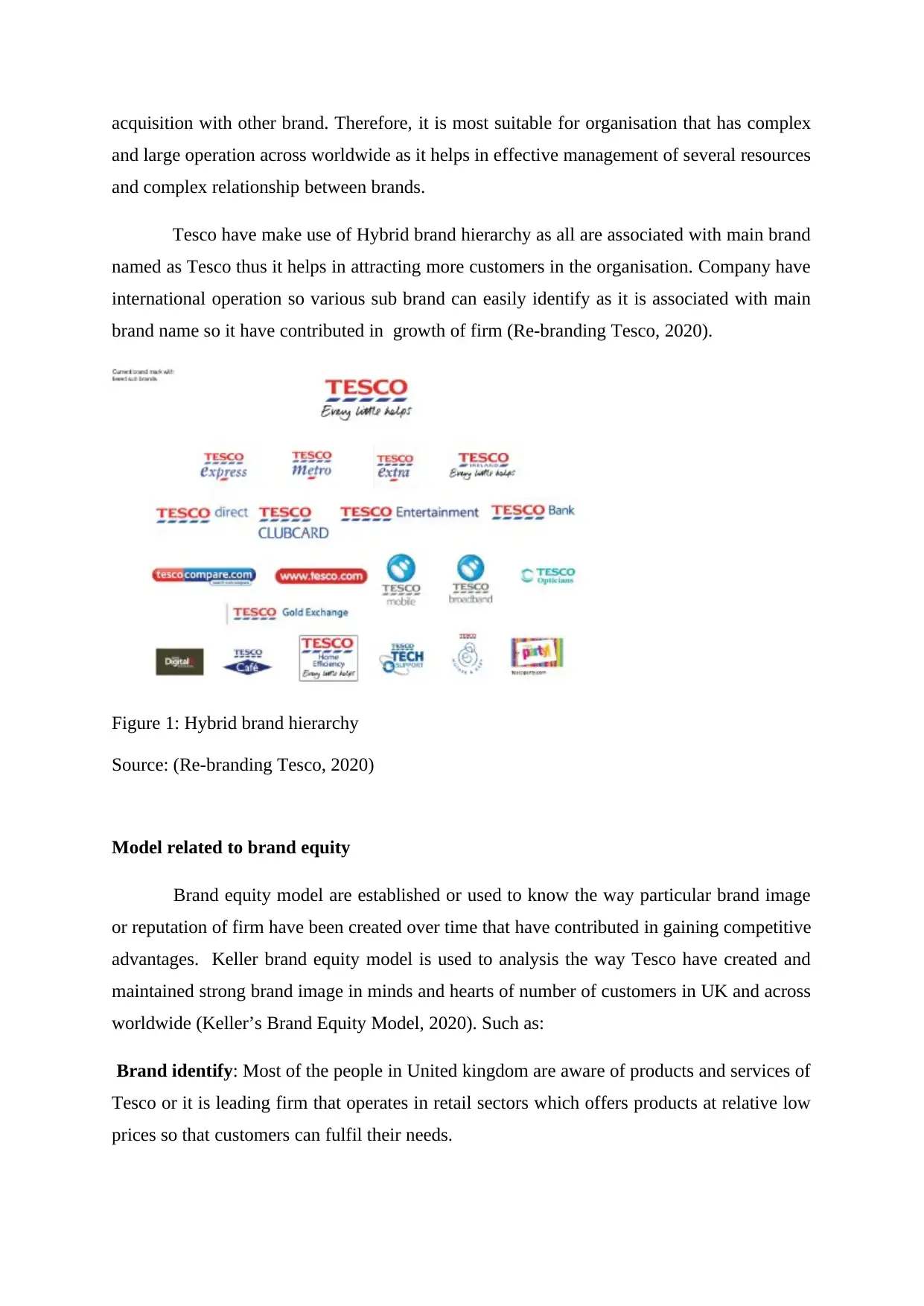
acquisition with other brand. Therefore, it is most suitable for organisation that has complex
and large operation across worldwide as it helps in effective management of several resources
and complex relationship between brands.
Tesco have make use of Hybrid brand hierarchy as all are associated with main brand
named as Tesco thus it helps in attracting more customers in the organisation. Company have
international operation so various sub brand can easily identify as it is associated with main
brand name so it have contributed in growth of firm (Re-branding Tesco, 2020).
Figure 1: Hybrid brand hierarchy
Source: (Re-branding Tesco, 2020)
Model related to brand equity
Brand equity model are established or used to know the way particular brand image
or reputation of firm have been created over time that have contributed in gaining competitive
advantages. Keller brand equity model is used to analysis the way Tesco have created and
maintained strong brand image in minds and hearts of number of customers in UK and across
worldwide (Keller’s Brand Equity Model, 2020). Such as:
Brand identify: Most of the people in United kingdom are aware of products and services of
Tesco or it is leading firm that operates in retail sectors which offers products at relative low
prices so that customers can fulfil their needs.
and large operation across worldwide as it helps in effective management of several resources
and complex relationship between brands.
Tesco have make use of Hybrid brand hierarchy as all are associated with main brand
named as Tesco thus it helps in attracting more customers in the organisation. Company have
international operation so various sub brand can easily identify as it is associated with main
brand name so it have contributed in growth of firm (Re-branding Tesco, 2020).
Figure 1: Hybrid brand hierarchy
Source: (Re-branding Tesco, 2020)
Model related to brand equity
Brand equity model are established or used to know the way particular brand image
or reputation of firm have been created over time that have contributed in gaining competitive
advantages. Keller brand equity model is used to analysis the way Tesco have created and
maintained strong brand image in minds and hearts of number of customers in UK and across
worldwide (Keller’s Brand Equity Model, 2020). Such as:
Brand identify: Most of the people in United kingdom are aware of products and services of
Tesco or it is leading firm that operates in retail sectors which offers products at relative low
prices so that customers can fulfil their needs.
⊘ This is a preview!⊘
Do you want full access?
Subscribe today to unlock all pages.

Trusted by 1+ million students worldwide
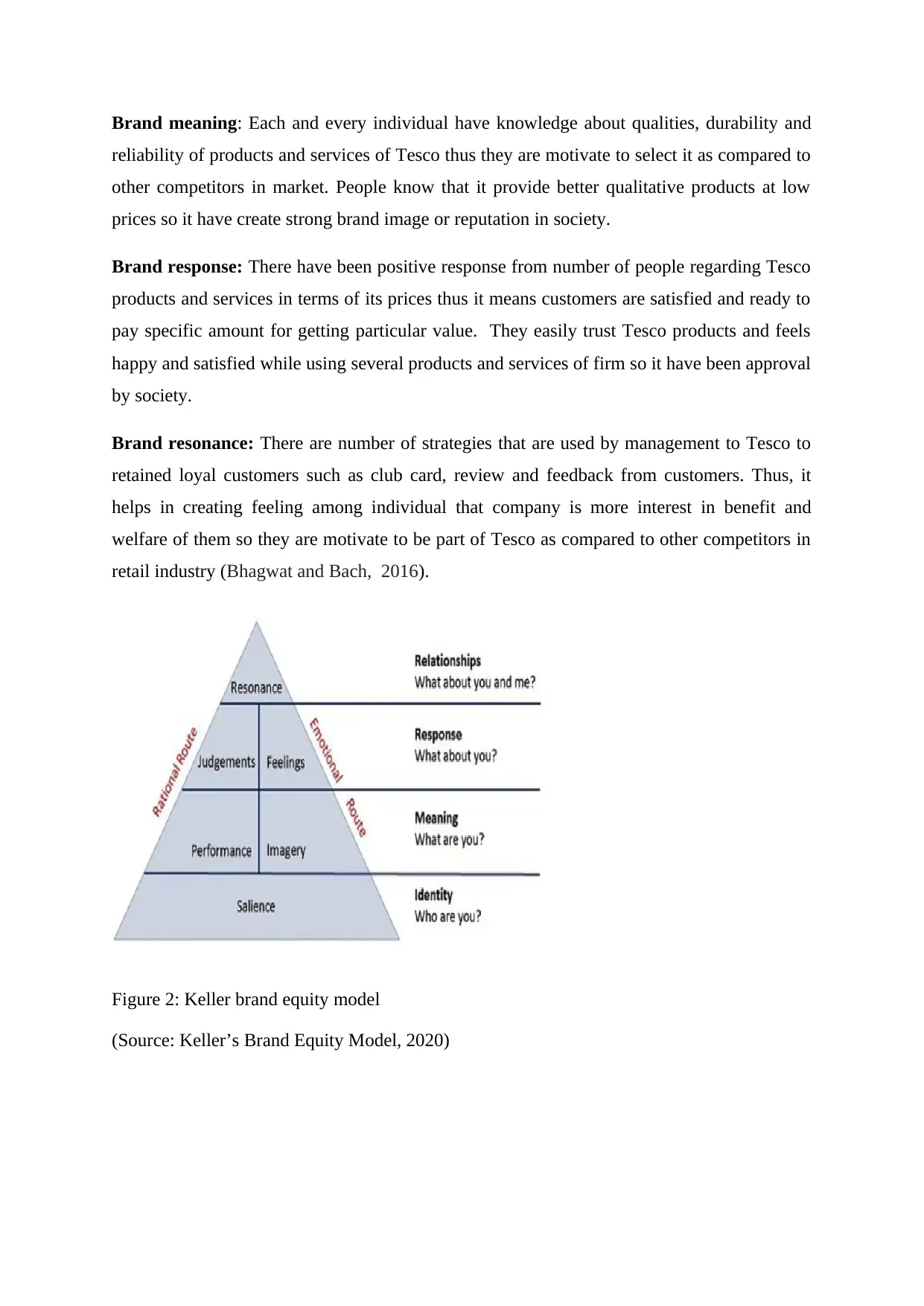
Brand meaning: Each and every individual have knowledge about qualities, durability and
reliability of products and services of Tesco thus they are motivate to select it as compared to
other competitors in market. People know that it provide better qualitative products at low
prices so it have create strong brand image or reputation in society.
Brand response: There have been positive response from number of people regarding Tesco
products and services in terms of its prices thus it means customers are satisfied and ready to
pay specific amount for getting particular value. They easily trust Tesco products and feels
happy and satisfied while using several products and services of firm so it have been approval
by society.
Brand resonance: There are number of strategies that are used by management to Tesco to
retained loyal customers such as club card, review and feedback from customers. Thus, it
helps in creating feeling among individual that company is more interest in benefit and
welfare of them so they are motivate to be part of Tesco as compared to other competitors in
retail industry (Bhagwat and Bach, 2016).
Figure 2: Keller brand equity model
(Source: Keller’s Brand Equity Model, 2020)
reliability of products and services of Tesco thus they are motivate to select it as compared to
other competitors in market. People know that it provide better qualitative products at low
prices so it have create strong brand image or reputation in society.
Brand response: There have been positive response from number of people regarding Tesco
products and services in terms of its prices thus it means customers are satisfied and ready to
pay specific amount for getting particular value. They easily trust Tesco products and feels
happy and satisfied while using several products and services of firm so it have been approval
by society.
Brand resonance: There are number of strategies that are used by management to Tesco to
retained loyal customers such as club card, review and feedback from customers. Thus, it
helps in creating feeling among individual that company is more interest in benefit and
welfare of them so they are motivate to be part of Tesco as compared to other competitors in
retail industry (Bhagwat and Bach, 2016).
Figure 2: Keller brand equity model
(Source: Keller’s Brand Equity Model, 2020)
Paraphrase This Document
Need a fresh take? Get an instant paraphrase of this document with our AI Paraphraser
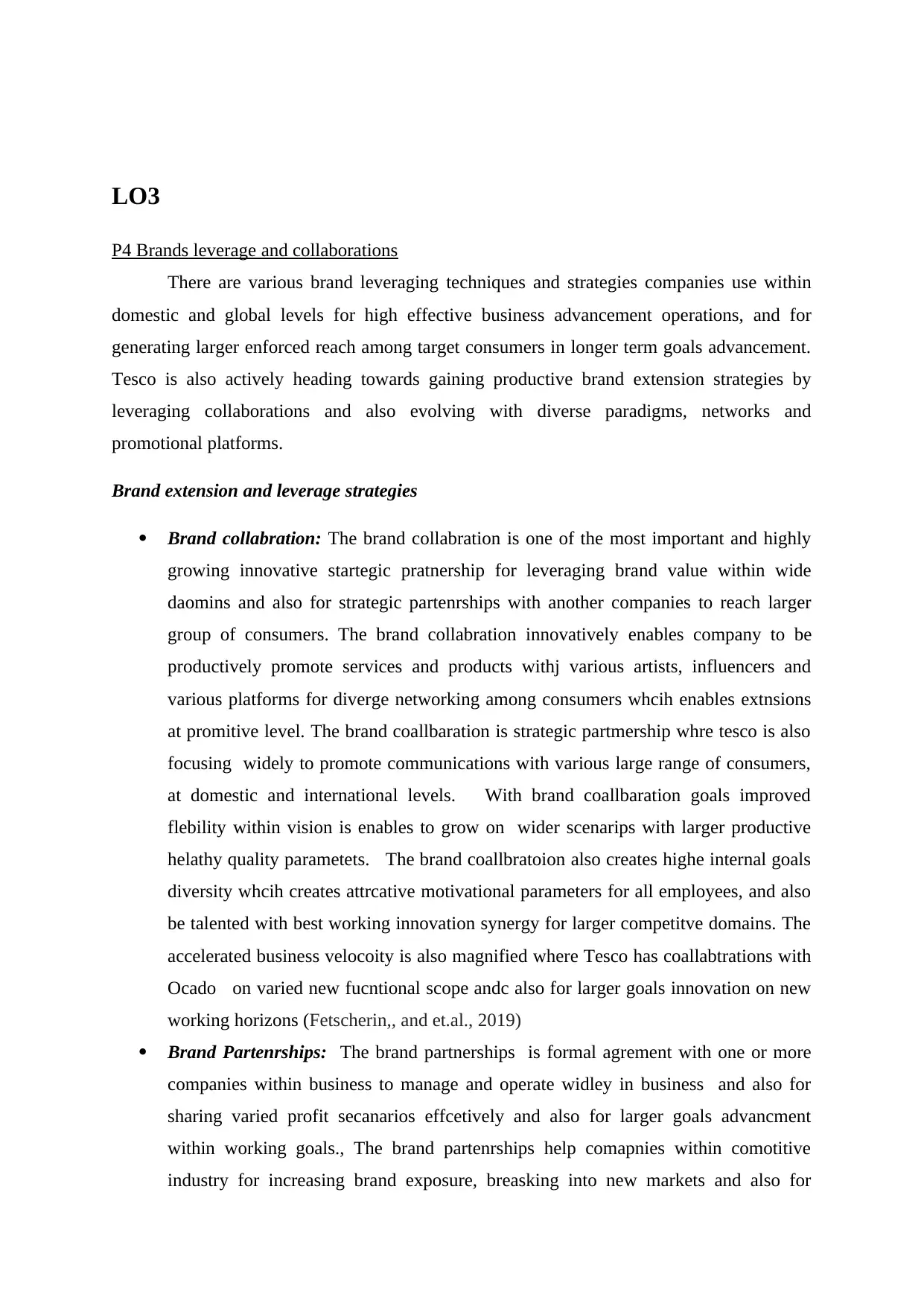
LO3
P4 Brands leverage and collaborations
There are various brand leveraging techniques and strategies companies use within
domestic and global levels for high effective business advancement operations, and for
generating larger enforced reach among target consumers in longer term goals advancement.
Tesco is also actively heading towards gaining productive brand extension strategies by
leveraging collaborations and also evolving with diverse paradigms, networks and
promotional platforms.
Brand extension and leverage strategies
Brand collabration: The brand collabration is one of the most important and highly
growing innovative startegic pratnership for leveraging brand value within wide
daomins and also for strategic partenrships with another companies to reach larger
group of consumers. The brand collabration innovatively enables company to be
productively promote services and products withj various artists, influencers and
various platforms for diverge networking among consumers whcih enables extnsions
at promitive level. The brand coallbaration is strategic partmership whre tesco is also
focusing widely to promote communications with various large range of consumers,
at domestic and international levels. With brand coallbaration goals improved
flebility within vision is enables to grow on wider scenarips with larger productive
helathy quality parametets. The brand coallbratoion also creates highe internal goals
diversity whcih creates attrcative motivational parameters for all employees, and also
be talented with best working innovation synergy for larger competitve domains. The
accelerated business velocoity is also magnified where Tesco has coallabtrations with
Ocado on varied new fucntional scope andc also for larger goals innovation on new
working horizons (Fetscherin,, and et.al., 2019)
Brand Partenrships: The brand partnerships is formal agrement with one or more
companies within business to manage and operate widley in business and also for
sharing varied profit secanarios effcetively and also for larger goals advancment
within working goals., The brand partenrships help comapnies within comotitive
industry for increasing brand exposure, breasking into new markets and also for
P4 Brands leverage and collaborations
There are various brand leveraging techniques and strategies companies use within
domestic and global levels for high effective business advancement operations, and for
generating larger enforced reach among target consumers in longer term goals advancement.
Tesco is also actively heading towards gaining productive brand extension strategies by
leveraging collaborations and also evolving with diverse paradigms, networks and
promotional platforms.
Brand extension and leverage strategies
Brand collabration: The brand collabration is one of the most important and highly
growing innovative startegic pratnership for leveraging brand value within wide
daomins and also for strategic partenrships with another companies to reach larger
group of consumers. The brand collabration innovatively enables company to be
productively promote services and products withj various artists, influencers and
various platforms for diverge networking among consumers whcih enables extnsions
at promitive level. The brand coallbaration is strategic partmership whre tesco is also
focusing widely to promote communications with various large range of consumers,
at domestic and international levels. With brand coallbaration goals improved
flebility within vision is enables to grow on wider scenarips with larger productive
helathy quality parametets. The brand coallbratoion also creates highe internal goals
diversity whcih creates attrcative motivational parameters for all employees, and also
be talented with best working innovation synergy for larger competitve domains. The
accelerated business velocoity is also magnified where Tesco has coallabtrations with
Ocado on varied new fucntional scope andc also for larger goals innovation on new
working horizons (Fetscherin,, and et.al., 2019)
Brand Partenrships: The brand partnerships is formal agrement with one or more
companies within business to manage and operate widley in business and also for
sharing varied profit secanarios effcetively and also for larger goals advancment
within working goals., The brand partenrships help comapnies within comotitive
industry for increasing brand exposure, breasking into new markets and also for

creating extra value among products and services for larger goals advancmnetnt.
Tesco is also one of the best brand within business industry where it is actively
heading with smart innovation in business partnerships and also for ststaing goal to
reach larger consumer tragtes divrselly where it is also working with smart productive
scenaios. The comany is engaing with consumers by partnership and for creating
brand value among consumers, focusing on solving varied problems and also for
generating wide reach where brand descrptions are gaining high scope within wider
domains (Nguyen, Melewar and Hemsley-Brown eds., 2019).
The partnerships beings brands together to help them rech new audiences and
also offer something wider and innovatoive among consumers for enhaicng
precerptions of brands successfully within wider domains, The successfull brand
partnerships also fucntionally brings high scope to market arenas and wider reach
within consmers keen innovative goals advancment, for leveraging diversity onto
wider arenas and also for generating high scale revenue grounds. Examples of
partrnerships are Starbucks and Spotify which has created one of the best innovative
partnership within business scenaios and also for new scale innovation working
syenrgy for best productive services , higher goodwill and revenue goals (France,
Merrilees and Miller, 2016).
Brand reinforcment strategies Global branding: The global branding is act of marketing for products and servics
under same working name in multiple countries with similar, centrally coordianted
marketing strategies and also for creating new high range of products and services for
consumers. The global branding has been anaysed as one of the major domain where
specialised focus is given by comapnies within wide compotitive industry scenaios
and also for keen growth avenues where best new productive services are marketed.
Tesco has high global positions and also is globally promoted due to its best working
operations of efficiency , where working force of new commercial stratgies has lead
to best brand managment strategies. It can be also understood that global branding has
not only opened up new doors of wider productive reach among consumers
segmented into various arenas and also for keeping up witth traget reach within larger
goals (Grubor and Milovanov, 2017). Global branding also reinforces stratgies to
keep up with best promotioanl stratgeis such as digital branding and also for keepin
up with new matreials expansion in products and services qualuty parametres. The
Tesco is also one of the best brand within business industry where it is actively
heading with smart innovation in business partnerships and also for ststaing goal to
reach larger consumer tragtes divrselly where it is also working with smart productive
scenaios. The comany is engaing with consumers by partnership and for creating
brand value among consumers, focusing on solving varied problems and also for
generating wide reach where brand descrptions are gaining high scope within wider
domains (Nguyen, Melewar and Hemsley-Brown eds., 2019).
The partnerships beings brands together to help them rech new audiences and
also offer something wider and innovatoive among consumers for enhaicng
precerptions of brands successfully within wider domains, The successfull brand
partnerships also fucntionally brings high scope to market arenas and wider reach
within consmers keen innovative goals advancment, for leveraging diversity onto
wider arenas and also for generating high scale revenue grounds. Examples of
partrnerships are Starbucks and Spotify which has created one of the best innovative
partnership within business scenaios and also for new scale innovation working
syenrgy for best productive services , higher goodwill and revenue goals (France,
Merrilees and Miller, 2016).
Brand reinforcment strategies Global branding: The global branding is act of marketing for products and servics
under same working name in multiple countries with similar, centrally coordianted
marketing strategies and also for creating new high range of products and services for
consumers. The global branding has been anaysed as one of the major domain where
specialised focus is given by comapnies within wide compotitive industry scenaios
and also for keen growth avenues where best new productive services are marketed.
Tesco has high global positions and also is globally promoted due to its best working
operations of efficiency , where working force of new commercial stratgies has lead
to best brand managment strategies. It can be also understood that global branding has
not only opened up new doors of wider productive reach among consumers
segmented into various arenas and also for keeping up witth traget reach within larger
goals (Grubor and Milovanov, 2017). Global branding also reinforces stratgies to
keep up with best promotioanl stratgeis such as digital branding and also for keepin
up with new matreials expansion in products and services qualuty parametres. The
⊘ This is a preview!⊘
Do you want full access?
Subscribe today to unlock all pages.

Trusted by 1+ million students worldwide
1 out of 18
Related Documents
Your All-in-One AI-Powered Toolkit for Academic Success.
+13062052269
info@desklib.com
Available 24*7 on WhatsApp / Email
![[object Object]](/_next/static/media/star-bottom.7253800d.svg)
Unlock your academic potential
Copyright © 2020–2025 A2Z Services. All Rights Reserved. Developed and managed by ZUCOL.





